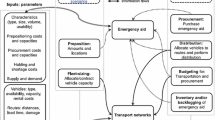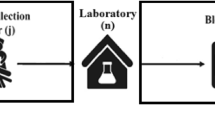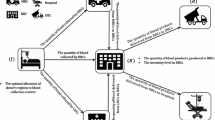Abstract
The importance of blood is heightened in disasters due to its vital role in saving human lives. This paper presents a robust and reliable model for a dynamic emergency blood network design problem. A robust approach is applied to control uncertainty. A p-criterion technique is used to protect the solution against the risk of disruptions. Furthermore, a numerical example is considered extensively to show the effect of considering disruption scenarios. The performance of the proposed model is studied using a series of test problems of various sizes. Results show that the performance of the model is quite satisfactory.





Similar content being viewed by others
References
Azad, N., & Davoudpour, H. (2011). Stochastic distribution network design with reliability consideration. Journal of Zhejiang University-SCIENCE C (Computers & Electronics). https://doi.org/10.1631/jzus.C11a0087.
Baş Güre, S., Carello, G., Lanzarone, E., & Yalçındağ, S. (2017). Unaddressed problems and research perspectives in scheduling blood collection from donors. Production Planning & Control,29, 1–7.
Beliën, J., & Forcé, H. (2012). Supply chain management of blood products: A literature review. European Journal of Operational Research,217(1), 1–16.
Bertsimas, D., & Sim, M. (2004). The price of robustness. Operations Research,52(1), 35–53.
Cetin, E., & Sarul, L. S. (2009). A blood bank location model: A multi objective approach. European Journal of Pure and Applied Mathematics,2(1), 112–124.
Cui, T., Ouyang, Y., & Shen, Z. J. M. (2010). Reliable facility location design under the risk of disruptions. Operations Research,58(4-part-1), 998–1011.
Daskin, M. S., Coullard, C. R., & Shen, Z. J. M. (2002). An inventory-location model: Formulation, solution algorithm and computational results. Annals of Operations Research,110(1–4), 83–106.
Delen, D., Erraguntla, M., Mayer, R. J., & Wu, C. N. (2011). Better management of blood supply-chain with GIS-based analytics. Annals of Operations Research,185(1), 181–193.
Diedrichs, D. R., Phelps, K., & Isihara, P. A. (2016). Quantifying communication effects in disaster response logistics: A multiple network system dynamics model. Journal of Humanitarian Logistics and Supply Chain Management,6(1), 24–45.
Dillon, M., Oliveira, F., & Abbasi, B. (2017). A two-stage stochastic programming model for inventory management in the blood supply chain. International Journal of Production Economics,187, 27–41.
Ding, H., Benyoucef, L., & Xie, X. (2009). Stochastic multi-objective production-distribution network design using simulation-based optimization. International Journal of Production Research,47(2), 479–505.
Drezner, Z. (1987). Heuristic solution methods for two location problems with unreliable facilities. Journal of the Operational Research Society,38, 509–514.
Duan, Q., & Liao, T. W. (2014). Optimization of blood supply chain with shortened shelf lives and ABO compatibility. International Journal of Production Economics,153, 113–129.
El-Sayed, M., Afia, N., & El-Kharbotly, A. (2010). A stochastic model for forward–reverse logistics network design under risk. Computers & Industrial Engineering,58(3), 423–431.
Fahimnia, B., Jabbarzadeh, A., Ghavamifar, A., & Bell, M. (2017). Supply chain design for efficient and effective blood supply in disasters. International Journal of Production Economics,183, 700–709.
Fisher, M. L. (2004). The Lagrangian relaxation method for solving integer programming problems. Management Science,50(12_supplement), 1861–1871.
Gavidia, J. V. (2017). A model for enterprise resource planning in emergency humanitarian logistics. Journal of Humanitarian Logistics and Supply Chain Management, 7(3), 246–265.
Gunpinar, S., & Centeno, G. (2015). Stochastic integer programming models for reducing wastages and shortages of blood products at hospitals. Computers & Operations Research,54, 129–141.
Gunpinar, S., & Centeno, G. (2016). An integer programming approach to the bloodmobile routing problem. Transportation Research. Part E: Logistics and Transportation Review,86, 94–115.
Hamideh, S. (2015). Planning for disaster recovery: Lessons from hurricane ike for theory and practice, Ph.D. Thesis.
Hasani, A., Zegordi, S. H., & Nikbakhsh, E. (2012). Robust closed-loop supply chain network design for perishable goods in agile manufacturing under uncertainty. International Journal of Production Research,50(16), 4649–4669.
Hatefi, S. M., & Jolai, F. (2014). Robust and reliable forward–reverse logistics network design under demand uncertainty and facility disruptions. Applied Mathematical Modelling,38(9), 2630–2647.
Hosseinifard, Z., & Abbasi, B. (2016). The inventory centralization impacts on sustainability of the blood supply chain. Computers & Operations Research,89, 206–212.
Jabbarzadeh, A., Fahimnia, B., & Seuring, S. (2014). Dynamic supply chain network design for the supply of blood in disasters: A robust model with real world application. Transportation Research Part E: Logistics and Transportation Review,70, 225–244.
Jabbarzadeh, A., Jalali Naini, S. G., Davoudpour, H., & Azad, N. (2012). Designing a supply chain network under the risk of disruptions. Mathematical Problems in Engineering. https://doi.org/10.1155/2012/234324.
Kara, S. S., & Onut, S. (2010). A two-stage stochastic and robust programming approach to strategic planning of a reverse supply network: The case of paper recycling. Expert Systems with Applications,37(9), 6129–6137.
Khalilpourazari, S., & Khamseh, A. A. (2017). Bi-objective emergency blood supply chain network design in earthquake considering earthquake magnitude: a comprehensive study with real world application. Annals of Operations Research. https://doi.org/10.1007/s10479-017-2588-y.
Kunz, N., Van Wassenhove, L. N., Besiou, M., Hambye, C., & Kovacs, G. (2017). Relevance of humanitarian logistics research: best practices and way forward. International Journal of Operations & Production Management, 37(11), 1585–1599.
Lee, D. H., & Dong, M. (2009). Dynamic network design for reverse logistics operations under uncertainty. Transportation Research Part E: Logistics and Transportation Review,45(1), 61–71.
Lim, M., Daskin, M. S., Bassamboo, A., & Chopra, S. (2010). A facility reliability problem: Formulation, properties, and algorithm. Naval Research Logistics (NRL),57(1), 58–70.
Listeş, O. (2007). A generic stochastic model for supply-and-return network design. Computers & Operations Research,34(2), 417–442.
Listeş, O., & Dekker, R. (2005). A stochastic approach to a case study for product recovery network design. European Journal of Operational Research,160(1), 268–287.
Mulvey, J. M., Vanderbei, R. J., & Zenios, S. A. (1995). Robust optimization of large-scale systems. Operations Research,43(2), 264–281.
Nagurney, A., & Masoumi, A. H. (2012). Supply chain network design of a sustainable blood banking system. In T. Boone, V. Jayaraman & R. Ganeshan (Eds.), Sustainable supply chains (pp. 49–72). New York, NY: Springer.
Nagurney, A., Masoumi, A. H., & Yu, M. (2012). Supply chain network operations management of a blood banking system with cost and risk minimization. Computational Management Science,9(2), 205–231.
Osorio, A. F., Brailsford, S. C., & Smith, H. K. (2015). A structured review of quantitative models in the blood supply chain: A taxonomic framework for decision-making. International Journal of Production Research,53(24), 7191–7212.
Osorio, A. F., Brailsford, S. C., Smith, H. K., Forero-Matiz, S. P., & Camacho-Rodríguez, B. A. (2016). Simulation-optimization model for production planning in the blood supply chain. Health Care Management Science,20, 1–17.
Peng, P., Snyder, L. V., Lim, A., & Liu, Z. (2011). Reliable logistics networks design with facility disruptions. Transportation Research Part B: Methodological,45(8), 1190–1211.
Pierskalla, W. P. (2005). Supply chain management of blood banks. In M. L. Brandeau, F. Sainfort, & W. P. Pierskalla (Eds.), Operations research and health care (pp. 103–145). Boston, MA: Springer.
Pishvaee, M. S., Jolai, F., & Razmi, J. (2009). A stochastic optimization model for integrated forward/reverse logistics network design. Journal of Manufacturing Systems,28(4), 107–114.
Pishvaee, M. S., Rabbani, M., & Torabi, S. A. (2011). A robust optimization approach to closed-loop supply chain network design under uncertainty. Applied Mathematical Modelling,35(2), 637–649.
Puranam, K., Novak, D. C., Lucas, M. T., & Fung, M. (2017). Managing blood inventory with multiple independent sources of supply. European Journal of Operational Research,259(2), 500–511.
Qi, L., Shen, Z. J. M., & Snyder, L. V. (2010). The effect of supply disruptions on supply chain design decisions. Transportation Science,44(2), 274–289.
Ramezani, M., Bashiri, M., & Tavakkoli-Moghaddam, R. (2013). A new multi-objective stochastic model for a forward/reverse logistic network design with responsiveness and quality level. Applied Mathematical Modelling,37(1), 328–344.
Ramezanian, R., & Behboodi, Z. (2017). Blood supply chain network design under uncertainties in supply and demand considering social aspects. Transportation Research Part E: Logistics and Transportation Review,104, 69–82.
Şahin, G., Süral, H., & Meral, S. (2007). Locational analysis for regionalization of Turkish Red Crescent blood services. Computers & Operations Research,34(3), 692–704.
Salehi, F., Mahootchi, M., & Husseini, S. M. M. (2017). Developing a robust stochastic model for designing a blood supply chain network in a crisis: A possible earthquake in Tehran. Annals of Operations Research. https://doi.org/10.1007/s10479-017-2533-0.
Salema, M. I. G., Barbosa-Povoa, A. P., & Novais, A. Q. (2007). An optimization model for the design of a capacitated multi-product reverse logistics network with uncertainty. European Journal of Operational Research,179(3), 1063–1077.
Samani, M. R. G., Torabi, S. A., & Hosseini-Motlagh, S. M. (2017). Integrated blood supply chain planning for disaster relief. International Journal of Disaster Risk Reduction,27, 168–188.
Sha, Y., & Huang, J. (2012). The multi-period location-allocation problem of engineering emergency blood supply systems. Systems Engineering Procedia,5, 21–28.
Sharma, B., Ramkumar, M., Subramanian, N., & Malhotra, B. (2017). Dynamic temporary blood facility location-allocation during and post-disaster periods. Annals of Operations Research. https://doi.org/10.1007/s10479-017-2680-3.
Shen, Z. J. M., Coullard, C., & Daskin, M. S. (2003). A joint location-inventory model. Transportation Science,37(1), 40–55.
Shen, Z. J. M., Zhan, R. L., & Zhang, J. (2011). The reliable facility location problem: Formulations, heuristics, and approximation algorithms. INFORMS Journal on Computing,23(3), 470–482.
Sheu, J. B. (2007). An emergency logistics distribution approach for quick response to urgent relief demand in disasters. Transportation Research Part E: Logistics and Transportation Review,43(6), 687–709.
Sheu, J. B. (2010). Dynamic relief-demand management for emergency logistics operations under large-scale disasters. Transportation Research Part E: Logistics and Transportation Review,46(1), 1–17.
Shishebori, D., & Yousefi Babadi, A. (2015). Robust and reliable medical services network design under uncertain environment and system disruptions. Transportation Research Part E: Logistics and Transportation Review,77, 268–288.
Snyder, L. V., & Daskin, M. S. (2006). Stochastic p-robust location problems. IIE Transactions,38(11), 971–985.
Snyder, L. V., Scaparra, M. P., Daskin, M. S., & Church, R. L. (2006). Planning for disruptions in supply chain networks. In M. P. Johnson, B. Norman, N. Secomandi (Eds.), Models, methods, and applications for innovative decision making (pp. 234–257). INFORMS.
Soyster, A. L. (1973). Technical note—convex programming with set-inclusive constraints and applications to inexact linear programming. Operations Research,21(5), 1154–1157.
Tang, C. S. (2006). Robust strategies for mitigating supply chain disruptions. International Journal of Logistics: Research and Applications,9(1), 33–45.
Zahiri, B., & Pishvaee, M. S. (2017). Blood supply chain network design considering blood group compatibility under uncertainty. International Journal of Production Research,55(7), 2013–2033.
Author information
Authors and Affiliations
Corresponding author
Rights and permissions
About this article
Cite this article
Rahmani, D. Designing a robust and dynamic network for the emergency blood supply chain with the risk of disruptions. Ann Oper Res 283, 613–641 (2019). https://doi.org/10.1007/s10479-018-2960-6
Published:
Issue Date:
DOI: https://doi.org/10.1007/s10479-018-2960-6




